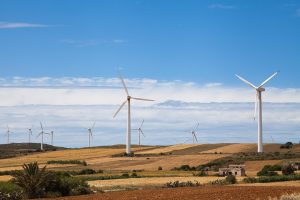Five weeks separate the High-level Dialogue on Energy (HLDE), convened by the UN Secretary General in September, and the Glasgow Climate Change Conference (COP 26), which is starting next week. This Policy Brief tracks the linkages between the two events, provides an update on countries’ net-zero commitments, and discusses the role of such pledges in achieving the goals of the Paris Agreement on climate change and the SDGs.
The HLDE and the international climate process are united in pursuit of interrelated goals. The Paris Agreement requires that countries reach global peaking of greenhouse gas (GHG) emissions as soon as possible to achieve a climate-neutral world by mid-century. The HLDE’s goal was to accelerate and scale up action to achieve universal access to clean, affordable energy by 2030 and net-zero emissions by 2050.
The Dialogue’s two main outcomes are a global roadmap to achieve SDG 7 and a set of energy compacts, which serve as the “vehicle to translate the global roadmap and key recommended actions into concrete plans with clear milestones and targets.”
Global Roadmap to SDG 7 and Net-zero Emissions
As part of the preparations for the Dialogue, five multi-stakeholder Technical Working Groups convened throughout the first half of 2021 to develop recommendations for action. The Ministerial Thematic Forums for the HLDE, which took place from 21-25 June 2021, launched five reports prepared by the Technical Working Groups on the Dialogue’s five priority themes. Together, the Technical Working Group reports and discussions held during the ministerials form the basis for the roadmap to achieve clean, affordable energy for all by 2030 and net-zero emissions by 2050.
According to a summary by UN-Energy, which highlights key recommendations and milestones towards the achievement of SDG 7 and net-zero emissions from the Ministerial Thematic Forums, key elements of the global roadmap include:
- Close the energy access gap: Direct energy policy, planning, financing and innovation to providing access to electricity for the 760 million people worldwide who lack it, and ensuring clean cooking solutions for the 2.6 billion people still relying on harmful fuels.
- Rapidly transition to clean energy pathways: Rapidly scale up energy transition solutions to reach 8,000 gigawatts (GW) of renewable energy by 2030, increase annual rate of energy efficiency from 0.8% to 3.0%, abandon all coal plants in the pipeline, and reduce coal power capacity by 50% by 2030.
- Leave no one behind, strengthen inclusion, interlinkages, and synergies: Integrate equity and equality in energy-sector policy, planning and financing, create green energy jobs, and mainstream energy-sector policies and strategies into strategies to ensure just energy transitions.
- Mobilize adequate and well-directed finance: Triple clean energy investment globally by 2030, accelerate access to finance, phase out inefficient fossil fuel subsidies, support market-based energy transitions. Create enabling policy and regulatory frameworks to leverage private sector investment.
- Harness innovation, technology and data: Expand the supply of energy innovation that addresses key gaps, and increase demand for clean and sustainable energy technologies and innovation through market-oriented policies, harmonized international standards, and carbon pricing mechanisms.
The summary identifies key quantitative milestones between now and 2050 necessary to achieve each of these elements. For example, the document notes that currently, renewable energy in the global energy mix is 20%, global renewable capacity is 2,799 GW, annual primary energy intensity improvement is only about 1%, and the share of fossil fuels in the global energy mix is 60%. To enable a rapid transition to clean energy pathways, by 2025, all countries need to have a comprehensive energy transition strategy. Global renewable power capacity needs to double, with 100 countries having targets for 100% renewable-based power and zero new coal power plants in the pipeline. The 2030 milestones are: 8,000 GW of renewables; double the global improvement in energy efficiency; 100 countries have achieved an annual energy efficiency increase of 3%; phase out coal within the Organization for Economic Co-operation and Development (OECD); and reduce fossil fuel share to 30% of the global energy mix. By 2050, net-zero emissions are achieved globally, 92% of power comes from renewable technologies, and coal is phased out globally.
Pledges to Reach Net Zero
Last week, Saudi Arabia’s crown prince Mohammed bin Salman announced Saudi Arabia’s goal of reaching net-zero emissions by 2060. To achieve this, the country plans to use its Circular Carbon Economy (CCE) approach, outlined in its nationally determined contribution (NDC) it submitted to the UNFCCC on 23 October.
On 26 October, Australia’s Prime Minister Scott Morrison announced the country’s pledge to reach net-zero emissions by 2050 but said it will not legislate the goal. Australia plans to achieve this target largely through technology development, and will rely on consumers and businesses to drive the transition.
The two countries join more than 130 states that have set or are considering a target of reducing emissions to net zero by mid-century. According to the Energy and Climate Intelligence Unit’s Net Zero Tracker, Canada, Denmark, the EU, France, Germany, Hungary, Japan, the Republic of Korea, Luxembourg, New Zealand, Spain, Sweden, and the UK have signed net-zero commitments into law, with Germany and Sweden aiming to reach carbon neutrality already by 2045. Chile, Fiji, and Ireland have proposed net-zero legislation. Forty-five countries, including major emitters such as China and the US, have net-zero goals reflected in policy documents, and almost 80 are considering targets. Frontrunners include Finland, which undertakes to be carbon neutral by 2035, and Austria and Iceland, which aim to achieve net-zero emissions by 2040. Suriname and Bhutan are the only two countries that are currently net negative.
Numerous non-state actors have also pledged to “race to zero.” According to the UNFCCC, 733 cities, 31 regions, 3,067 businesses, 173 of the biggest investors, and 622 higher education institutions have announced net-zero commitments of their own.
New or updated NDCs
Under the Paris Agreement, countries need to update their climate plans and increase ambition. In September, the UNFCCC Secretariat published an NDC synthesis report (FCCC/PA/CMA/2021/8), covering “the 164 latest available NDCs, representing all 191 Parties to the Paris Agreement, including the 86 new or updated NDCs communicated by 113 Parties, recorded in the interim NDC registry as at 30 July 2021, covering 93.1 per cent of the total global emissions in 2019.” According to the document, within the group of 113 countries, 70 reported carbon neutrality goals “around the middle of the century.”
The UNFCCC references the Special Report on Global Warming of 1.5°C (SR15) by the Intergovernmental Panel on Climate Change (IPCC), which finds that, “to be consistent with global emission pathways with no or limited overshoot of the 1.5°C goal, global net anthropogenic CO2 emissions need to decline by about 45 per cent from the 2010 level by 2030, reaching net zero around 2050.” While there is “a clear trend” that GHG emissions are being reduced over time, the planned combined emissions reductions by 2030 still fall far short of the level of ambition needed to achieve the Paris Agreement goal of keeping the global average temperature rise to 1.5°C. For example, analysis by Climate Action Tracker indicates that Australia, Brazil, Indonesia, Mexico, New Zealand, the Russian Federation, Singapore, Switzerland, and Viet Nam are among the countries whose new or updated NDCs failed to increase ambition.
On 25 October, the UNFCCC Secretariat published an update (FCCC/PA/CMA/2021/8/Rev.1), covering 165 latest available NDCs, “including the 116 new or updated NDCs communicated by 143 Parties, recorded in the interim NDC registry as at 12 October 2021, covering 94.1 per cent of the total global emissions in 2019.” In it, the UNFCCC confirms that for all available NDCs of all 192 Parties taken together, an increase of about 16% in global GHG emissions in 2030 compared to 2010 is expected. Such an increase in emissions translates to a global average temperature rise of about 2.7°C by the end of the century.
The road ahead
With the Glasgow Climate Change Conference fast approaching, many countries are using the opportunity to communicate new or updated NDCs. As of 27 October, nine additional countries had submitted their new or updated NDCs since 12 October 2021. In October alone, the NDC interim registry has received around 30 communications, bringing the total number of countries to have updated their climate action plans to 158 – nearly 83% of parties to the Paris Agreement.
Notably, China and India, jointly responsible for over 30% of global emissions (24% and 7%, respectively), are yet to submit their new or updated NDCs. Also, China’s worsening power crisis and reported increases in domestic coal consumption may lead to a less ambitious climate plan China said it will deliver before November.
While net-zero pledges – if fully implemented – “could make a big difference,” “mid-century net-zero targets need to be backed up by 2030 targets that put countries on a credible path to zero out emissions by mid-century.” Launching this year’s Emissions Gap Report, which finds that the “latest climate promises for 2030 put the world on track for a temperature rise this century of at least 2.7°C,” Inger Andersen, Executive Director, UN Environment Programme (UNEP) said countries “need to make their net-zero pledges more concrete, ensuring these commitments are included in NDCs, and action brought forward.”



